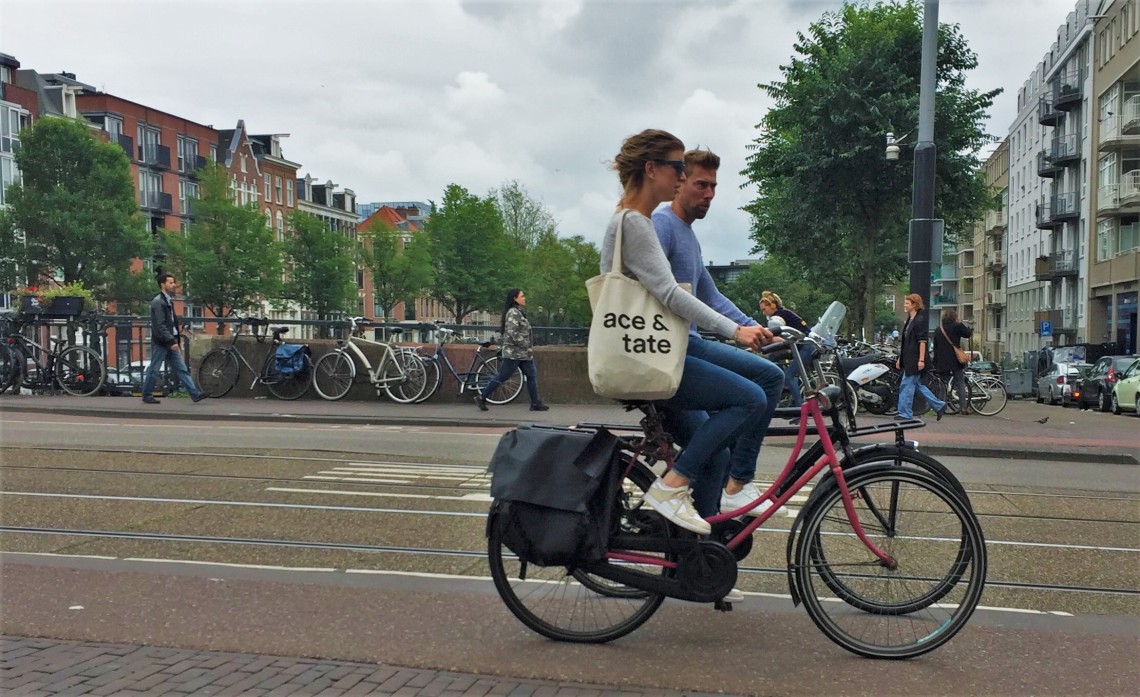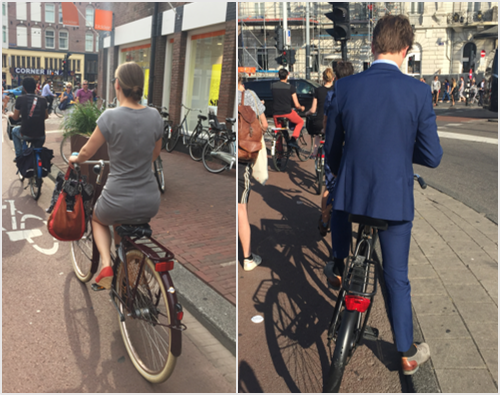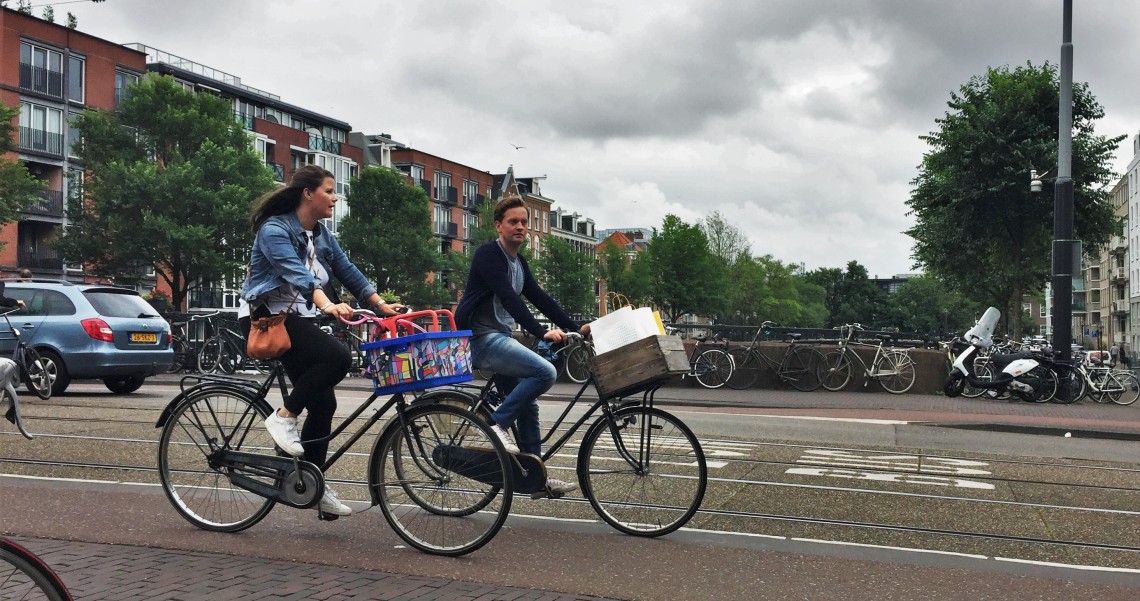At home in Toronto, I ride my bike all the time. I ride for commuting, for leisure, for travel, and for shopping. Most of the time I wouldn’t dare ride without a helmet, and most of the time I ride by myself. I often wear more athletic clothes when I cycle, and many others do the same. I can even hear my mom’s voice ringing in my head when I leave on a ride “make sure you wear a helmet!”.
So, imagine my surprise when I arrived in Amsterdam and saw Dutch cyclists riding without helmets, side-by-side, and in normal clothing.

My three weeks in the Netherlands has dramatically shaped the way I think about cycling, and in particular, my perspective on the way we talk about cycling. I’ve come to realize that in its current state, public messaging about cycling in North America actually discourages it, by making it sound cumbersome and dangerous. Here’s some ways we can improve.
Stop demanding that cyclists wear helmets

One of the first things I noticed when I arrived in Amsterdam is that the Dutch don’t wear helmets when they ride – most of the time not even children. In general, if you have a helmet on, you’re likely either a sport cyclist or a visitor on a bike tour. In fact, only 2% of Dutch cyclists wear one. Contrast this to messaging back home around cycling, where riders are strongly encouraged to wear helmets and public campaigns and safety messages are heavily focused on them.

Why does this matter? It dramatically shapes the image of cycling. Wearing a helmet suggests that cycling is unsafe. It also creates a barrier to access (another $40 expense, and something else to carry around with you all day). They also look incredibly tacky and mess up your hair (seems silly but this is a real stated barrier to cycling). We should allow cyclists to assess these risks themselves, rather than trying to force helmets upon them.
Stop associating the activity of cycling with the sport of cycling
One of the top stated barriers to commuter cycling in North America is that people fear exposure to the elements, and they don’t want to arrive at work sweaty. It’s the main reason why gold-standard cycling facilities often contain showers. But this is still looking at the problem in the wrong way – adding showers perpetuates the idea that cycling is a sweaty, physically-demanding activity. For most of the Dutch, cycling is a relaxing means of travel, not a “morning workout”. They ride upright, at a leisurely pace of 16km/h (on average), so that you barely experience an increase in heart rate when you ride.

Don’t make going out on a bike seem like an expedition
Quite often public messaging to cyclists tries to be a bit too helpful in preparing them for riding. Consider the messaging on the GO Transit website aimed at cyclists biking to the train:
Some things you’ll need for your ride:
Helmet, lock, lights, water, maps, and a PRESTO card.Tip! Check the forecast—you may also need rain gear.
All of a sudden, your leisure ride has become the equivalent of preparing for a camping trip! By making an extensive list of preparation items, we create yet another barrier to doing it. Does the GO website have a page suggesting that drivers bring a warm blanket and first aid kit, and to check their airbags before they drive to the station? Of course not!
Enable people to be social on bikes
Humans are social people who enjoy social activities, and cycling is no exception. Riding at a leisurely pace through a city or along a trail is a perfect opportunity to have a casual conversation with a friend, by riding alongside one another. The Dutch recognize this and build trails that are wide enough for cyclists to comfortably ride beside each other, in both directions (4m wide is the gold standard in Netherlands).

When we “squeeze” out 1.5m for a bike lane on a road in North America, we’re not making space for cyclists, we’re making space for “cyclist”. Even many of our multi-use trails are dreadfully narrow. This discourages social riding, and suggests that cycling is an individual activity. What’s the first place you expect to sit in a car when you’re a passenger? The front seat of course! It’s natural to sit next to the person you’re traveling with, and enables you to have engaging, enjoyable conversations with them.
Cycling is easy, and cycling is fun. So why does our messaging and design approach to cycling suggest the opposite? Going on a bike ride, whether it’s to the store, train station, or without any destination in mind, is not a dangerous expedition. Cyclists should of course be aware of the risks, but overemphasizing these risks works against our efforts to encourage cycling.


Matt, very excellent post! One of the best summations of the differences between The Netherlands and U.S. I’ve read.
LikeLike
Thanks so much, I hope you’re able to put some of it into practice in Twin Cities! I’m enjoying checking out your site as well.
LikeLike
Thank you. Better stuff here: https://streets.mn/author/wangell/
LikeLike
Great read!
LikeLike
Thanks Martijn!
LikeLike
Reblogged this on CycleBath.
LikeLike
Thanks for sharing!
LikeLike
Right on the nose.
Yes, the problem is systemic. “The system” in North America has been intentionally designed to sell cars and to suppress any alternative. By framing cycling (and transit) as complicated and unattractive, they guarantee that people will think it’s not for them. This has permeated the culture so much that, in the case you show, even the transit agency is essentially encouraging people to drive.
LikeLike
Well it’s never too late to change and I think we’re slowly starting to wake up and realize where we need to focus. Toronto’s downtown population is expected to double in the coming decades with no possibility of expanding the road network. So in order to move forward we’re going to have to leave the car behind, and I think the City is realizing it.
LikeLike
Hi Matt! Just arrived from The Netherlands and I feel much the same. It has also changed a lot the way I see cycling here in my city. Im glad I found your post. Have you got any social network profile I can follow? Have a great day!
Tincho – Buenos Aires
LikeLike
For sure! I’m on twitter every now and then @MattPinder1 . Glad you found the post helpful!!
LikeLike
Great post and love the comment about the Dutch not making cycling an exercise. I cringe every time I travel o Amsterdam for work and spend a week there then have to return North America where I see overweight middle-aged men on $5000 bikes, clad in Lycra puffing and panting their sweaty way to the office…. It’s just so awful to look at. What is this obsession with the need to look like you are in the Tour d France (just to travel to the office) or having huge panniers all over your bike as if you are travelling across the country (when all they contain is your lunch) It’s so ridiculous.
One thing to note about the helmets. The Dutch don’t wear helmets not because they cycle better, but because the drivers in the Netherlands are more cautious (and most, if not all drivers are also cyclists.) We wear helmets here in North America because drivers (and other cyclists) are dangerous and aggressive risk takers. Hence the whole cycling environment is less safe (including cars and bikes being made to mostly share the same road)
LikeLike
Dutch drivers are no different the US drivers. The difference is completely in road design. US traffic engineers design for Level Of Service (LOS) which is low delay for motor traffic and assume that drivers will obey laws, Dutch (and other EU engineers) assume that drivers will make a lot of mistakes and design for that.
Dutch traffic lanes are narrower and have imminent threats (e.g., cement curbs, rocks, parked cars) that cause drivers to pay close attention. Junctions have narrow radiuses that force drivers to slow when turning. They do not allow Right Turn On Red. Light signal cycles provide for protected movements and separation in time.
Put Dutch drivers on US roads and they’ll drive just as bad as US drivers. Put US drivers on Dutch roads and they are forced to drive like Dutch.
IOW, Cement enforces better than paint or paper.
LikeLike
I agree opaangell. Drivers adapt their behaviour in all contexts based on the built environment. Even cycling to different parts of the same city I see drastically different driver behaviour. It’s all about where we place cars on the street design hierarchy.
LikeLike
Before visiting the Netherlands, I saw not wearing helmets as a problem. But now that I know the Dutch have moved beyond helmets, I’m thinking of them as an “indicator” of the perceived safety of a city. The more people biking without helmets, the safer people feel. The eventual goal should be to have no cyclists wearing helmets (except the sporty Lycra ones).
LikeLike
Reblogged this on iNLand fIEts and commented:
Another writer experiences the joy of Dutch biking for the first time.
LikeLike
Great, thanks! And yes, it’s remarkable how much can be learned from the Dutch. It was an amazing experience travelling there.
LikeLike
Greetings from Aotearoa New Zealand. Great article, and real good thoughtful comments.
The coddling instructions:- Some things you’ll need for your ride:
Helmet, lock, lights, water, maps, and a PRESTO card.
Tip! Check the forecast—you may also need rain gear suggest that the writer, obviously a car driver, consider cyclists to be inferior beings and therefore need to be patronised.
I always ride with a helmet, and I would do so even if it were not compulsory. Holland is flat and so there may not be as much risk as there is where the terrain has hills and higher speeds?
Also the Dutch have laws, I believe, where the bigger vehicle is automatically considered to be at fault when there is a collision. With this law pedestrians and cyclists and motorcyclists do not get run over with careless abandon by drivers in larger vehicles, because the driver of the larger vehicle is considered to be at fault in the event of an accident and is therefore more circumspect around smaller vehicles and pedestrians.
LikeLiked by 1 person
These are definitely aspects that support safety for cycling in the Netherlands. I don’t remember once feeling unsafe while biking there, not even at busy intersections. I’m planning to dedicate an entire blog post (or several) to the Dutch infrastructure philosophy (so stay tuned!).
You’re correct on the liability rules – in any driver-person collision, the driver is automatically assumed to be at fault and must prove that the cyclist/pedestrian did something that was unexpected (this is very hard to do).
I think the helmet (or rather lack thereof) is an indicator of the safety of a city’s streets. When you give people the choice to wear one, and they choose not to, this means they feel safe enough to not wear one. I recently stopped wearing one when I bike around downtown, because I genuinely do feel safe biking on the streets of downtown Toronto. It was a liberating experience to not wear a helmet for the first time!
LikeLike
I was wondering about this.
I had the good fortune to spend 3 weeks cycling the Netherlands about a decade ago. Upon returning I ditched the bike helmet and cycling clothes. Now I just lock up the house, wheel the bike out of the shed and off I go. I live in Don Mills and cycle all over the city, in attire appropriate for the function I’m travelling to.
An unexpected upside: when you’re cycling in your fancy cocktail dress, drivers notice you. Honestly! I never feel as safe cycling as when I’m cycling dressed to the nines.
LikeLike
Very interesting story Veronica! I agree (minus the cocktail dress, which I have not experienced). When I don’t wear a helmet, I also naturally bike slower and more carefully. Contrasting my new riding habits to before Amsterdam, I actually think I’m safer now than when I actually wore a helmet.
LikeLike
Great article.
> Why does this matter? It dramatically shapes the image of cycling. Wearing a helmet suggest that cycling is unsafe.
This is missing the point: The point is that 1) very, very few cyclists hit their head, and 2) bicycle helmets are obviously way too light to protect cyclists if they’re hit by a motorized vehicle.
As you’ve seen in the NL, the solution is not to turn cyclists into robocops but to build infrastructures that are safe by design: Segregated bike lanes when space allows, 30km/h speed limit when not. And the police should make sure those are respected.
LikeLike
Agree with you 100%. Build a safe travel environment and safety gear is no longer needed. Only then can the bicycle become an everyday activity for everyone. The fact that many children don’t wear helmets speaks to the safety of cycling when you eliminate conflicts with motor vehicles.
LikeLike
We have much the same issues here in Oz. Cycling as a mass transportation alternative could transform our major cities but it is a hard slog to convince the public (especially women!) how simple it could all be. Add to this serious under investment in cycle paths and public transport infrastructure and I fear it may be some time time before this is seen as a serious alternative. On your other points; Personally I would never ride without a helmet these days (nor would I ski without one) but perhaps that is the effect of middle age! And I totally agree that there is a distinct difference between serious cyclists and bikeriders, I am of the latter!
LikeLike
In theory helmets should be beneficial, in practice they have proven to be ineffective. The rate of TBI (traumatic brain injury as a percent of all bicycle injuries) among bicycle riders is effectively the same, 33%, in countries where nobody wears a helmet like The Netherlands as in countries where many do such as the U.S. and where nearly 100% do like Australia. If helmets were effective then the rates in Australia and the U.S. should be much lower.
Though historical data is more difficult to obtain, it appears that the rates of TBI have not changed when helmet wearing changed. E.G., the rates do not appear to have gone down when Australia or some Canadian provinces implemented mandatory helmet laws.
On a population level, foam bicycle helmets appear to make no measurable difference which begs the question if they ever make any difference at all beyond lessening minor abrasions and discouraging people from riding.
Why?
As mentioned above, most injuries and deaths do not involve any head injury at all. A helmet does no good against blunt force trauma to our abdomen for instance.
Helmets are only effective in very specific instances of force, trajectory, angle, and the shape of the struck object. A helmet is of little or no use outside of these narrow parameters which accounts for how many deaths and concussions there are every year due to TBI of people wearing helmets.
Helmets are only effective when worn perfectly properly. An anecdotal study of school children indicated that 92% were not wearing them properly. Interestingly, a similar anecdotal study of 35 people on a club bicycle ride (Twin Cities Bicycle Club) indicated that 23 of the 35 were not wearing them properly. Even when fit and worn properly though they are only effective within a very narrow range of crash types (above).
LikeLike
This is really interesting! So contrary to what we’re all taught growing up.
LikeLike
great blog Matt! Question for you (you may or may not have the answer): how did the Dutch get to where they are, and what can we learn from that process? Obviously it’s good to have a vision of where Toronto (and other cities) could be, but getting there is a challenge when the system is set up to encourage driving / discourage biking, which effectively limits the demand (both public and political) for doing anything about that.
Was it always this way in Amsterdam, or did they too have to fight to get safe space for cyclists on the roads there?
LikeLike
Hey Felix, that is a big question, and one that was the focus of my three-week study in Amsterdam. 40-50 years ago the Dutch had a very similar mindset to North American traffic planners, but through strong social movements, protests, and revolts, they chose a different future for their city, and started building streets that were safe for everyone.
LikeLike
Hi Felix
As always Mark Wagenbuur has the answer;
https://bicycledutch.wordpress.com/2011/10/20/how-the-dutch-got-their-cycling-infrastructure/
Enjoy the archives.
Leafs
LikeLike
Matt,
Your suggestion that we stop demanding cyclists wear helmets is very irresponsible. I have ridden in both countries on bike trails, lanes and on the road. I hope you never hit your head while cycling. It can be pretty ugly.
There are several things that make riding in the Netherlands different than in the U.S. For one, the Netherlands is flat. There are no down hills to built up speed. There are also dedicated bike lanes in the Netherlands that are just starting to get built in the U.S.
Cycling as transportation has been around much longer in the Netherlands than it has in the U.S. so U.S. motorists are not used to bikes being around.
I’m all for cycling but to tell people that they don’t need a helmet is not responsible. You need to correct the article and include the points I just made.
Mark
LikeLiked by 1 person
Hi Mark, I understand your points and concerns, but they do not change my view, which is that people who ride bikes are capable of assessing the environmental risks themselves. I’m not anti-helmet, and I wear one myself when I go on longer rides and when I go beyond the safer cycling areas in downtown Toronto, but there are many cycling situations where helmets simply aren’t needed. And building up speed on a downhill is a choice – riding at a slow speed without a helmet is no more dangerous than riding fast downhill with one.
LikeLike
Matt,
Does Toronto or Ontario require helmets for adults? If so, then I don’t agree that it needs to be mandated. I remember reading about a jurisdiction that required adults to wear helmet and cycling frequency went way down.
Obviously, there are situations where one doesn’t necessarily need a helmet as in the case of using bikeshare in an urban area with bike lanes or trails. I do so sometimes.
People do need to understand the consequences of not wearing a helmet, and bad hair isn’t a legitimate one IMHO.
LikeLike
The most recent study I remember indicated no changes in the rates of TBI with road racing cyclists since various helmet regulations were instituted. This includes Pro, Elite, and amateur, and covers both racing and training.
The only place I am aware of that bicycling helmets have shown any efficacy is with off-road mountain biking.
I wonder if it isn’t a far greater disservice to people to make them believe that something provides some safety benefit when it likely provides none.
LikeLike
In The Netherlands velo-mobiles can reach 70 km/h.
Cycling from the bridge I cross every day I routinely reach 40 km/h, highest measured from that bridge: 58 km/h.
We do have hills in the eastern and south eastern part of The Netherlands.
Anyway, it is irrelevant if a country is hilly/mountainous or not. Most cities aren’t.
You save many more lives by building a liveable urban infrastructure, which is mostly nonexistent in the USA.
Besides, if you want to save lives it should be mandatory to wear helmets in cars. The amount of head trauma in a car due to a traffic accidents statistically exceeds the head trauma involved in traffic accidents with bicycles.
By the same measure, do you find it irresponsible that not a single car driver or car passenger wears a helmet?
LikeLike
Yes, I agree that building the infrastructure is the most important factor, and although I have not been to the southern or eastern areas of the Netherlands, I do there are hills.
I don’t believe bike helmets should be required for adults. Helmets for car drivers would be ridiculous. There are many other safety measures that manufacturers can add to automobiles.
LikeLike
Fixed: “I don’t believe bike helmets should be required for adults. Helmets for car drivers would be as beneficial (or more so) as for bicycle riders. There are many other safety measures that traffic engineers can add to our roads*.”
* See CROW Design Manual for Bicycle Traffic.
LikeLike
My city has plenty of hills and almost twice the square mileage of Amsterdam.
LikeLike
I got the feeling you’ve never been to or even heard of San Francisco Pittsburgh or LA https://www.citylab.com/transportation/2014/02/10-truly-hellish-hills-american-cyclists/8511/
LikeLike
I enjoyed your article too, thank you.
Helmets are common here, especially for youth, since they’re required by CA law. It seems more people own a helmet than own a bike pump here.
In 2009 I launched a public service project to help HER / Mother Earth by encouraging bicycling. Participating businesses and organizations give 10-50% discounts to people who bike, and they’re only required to give those discounts one day a week,Thursdays. In order to avoid the need for a plastic card, coupon, etc., a helmet came to mind as something to serve as evidence of biking. Hence, the HER Helmet Thursdays Project.
As I mentioned when I opposed proposed legislation mandating helmets for adults, HER Helmet Thursdays is not about wearing a helmet. http://marilynch.com/blog/its-not-about-the-helmet.html To learn about the project, which is suitable for any geographic location, see: http://marilynch.com/blog/her-helmet-thursdays
LikeLike
Hi Matt. My name is Mirna and I work for Metro Morning on CBC Radio. I came across this article and I’d like to ask you a few questions about it on the phone. My office number is 416-205-5798. Please let me know. Cheers!
LikeLike
Hi Mirna, happy to chat about the article. I’ll call your office at 4:30 today if that works.
Matt
LikeLike
Excellent! Thank you. Looking forward to hearing from you.
LikeLike
Having just returned frim Netherlands to Toronto, I’ve spent days mulling over the differences. To me the biggest one is that cyclists are given priority. I encountered many points where the cycling path crossed perpendicular to the road, and there was a speed hump and yield sign so that the motorists would yield to cyclists. It also seems normal in Amsterdam for roads to be one way for motor traffic and two way for cyclists. Also the smaller residential roads are designed so motorists are forced to slow down. Whereas here, roads are wider and have long straight sections which encourage motorists to speed. And don’t forget the cyclists-only roundabouts and bridges in the Netherlands. This multifaceted focus on prioritizing cycling means that it feels incredibly easy and safe. At no point in the Netherlands did I have cars whizzing by me at high speeds. Whereas it’s a regular occurrence in Toronto. The Bloor Street sharrows near Avenue Road are a perfect example of highly stressful cycling “infrastructure” that you would never see in the Netherlands.
LikeLike
Agreed! The Dutch do such a great job of prioritizing peds and cyclists, and their infrastructure is amazing. I’ll be posting more on these topics in the coming months 🙂
LikeLike
Hi Matt!
I can’t find your contact info, but I’d like to email you about a cycling/design talk/event I am organizing. You can message it to me on twitter, @sarahlazarovic
This is a great post!
Thanks!
LikeLike